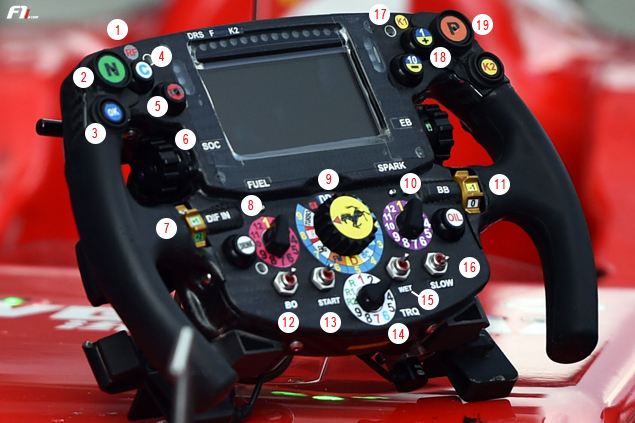Most Formula One steering wheels were given a major overhaul last year with the introduction of bigger LCD screens that display hundreds of data and suit better the complex technology of the new hybrid-powered cars.
Following the FIA’s clampdown on radio conversations, several teams that still had a small screen (Red Bull, Williams, and Lotus) decided to switch to the larger PCU-8D model for 2015. This forced them to redesign their steering wheels in order to accommodate this new device
While some settings feature on all steering wheels, others are specific to each team as you are about to find out.
1 – RF (“Rear Flap”): activates the Drag Reduction Sytem (DRS) ; 2 – N: takes the car out of gear and puts it in neutral; 3 – OK: enables the driver to acknowledge a piece of information or an instruction given by the team without having to talk over the radio; 4 – C: quickly adapts the engine map; 5 – switches on the radio to talk with the race engineer; 6 – SOC (“State of charge”): manages the conditions of the battery pack in terms of charging and discharging; 7 – DIF IN: adjusts settings of the differential on corner entry; 8 – FUEL: adjusts the fuel mix; 9 – MF (“Multifunction”) : similar to a menu, selects various strategies linked to engine management, ERS, brake balance, etc.; 10 – SPARK: sets up engine mapping; 11 – BB (“Brake Balance”) : distributes the pressure between the front and the rear brakes; 12 – BO (“Burn Out”): gives a temporary boost; 13 – START: selects the torque map for the start and pit stop ; 14 – TRQ (“Torque”): selects the best torque map for acceleration on corner exit; 15 – WET: adjust all the parameters to wet-weather conditions; 16 – SLOW (unknown function) ; 17 – K1 and K2 : quick-change buttons linked to ERS use ; 18 – +1 / –10 : increases or lowers the value for the selected option on the multifunction rotary dial; 19 – P (for “Pit Limiter”) : keeps legal speed in the pit lane.








